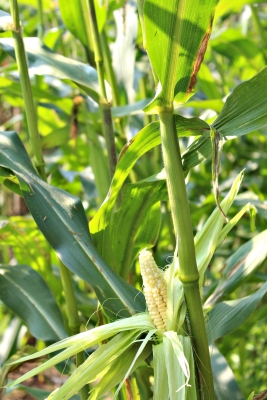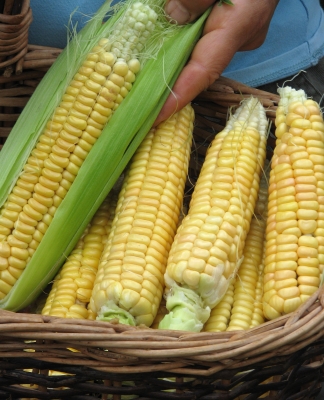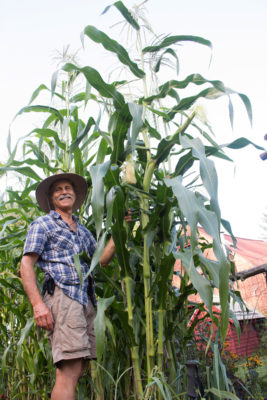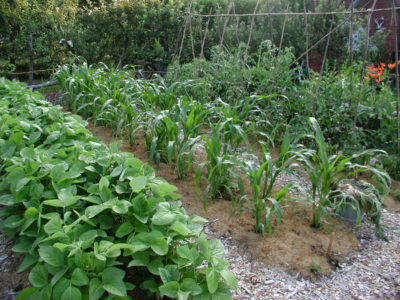SWEET CORN OP-ED
Ah, the Good Ole’ Days
The good ol’ days seemed to have had snowier winters, greener grass, and more toothsome apples. Perhaps it was so. One thing those good ol’ days definitely did not have was sweeter sweet corn. Only in the past few decades have plant breeders found new genes that shoot the sugar content of sweet corn sky-high.

Papoon corn, the first recorded variety of sweet corn, probably originated as a chance mutation of a single gene of field corn. That gene, the so-called sugary gene (abbreviated su), brought the sugar level in corn from four percent up to ten percent.
We gardeners have tried to make the most of that ten percent ever since the time when 18th century Plymouth, Massachusetts gardeners first grew Papoon corn. We pick an ear just when each kernel is creamy and as sweet as can be. Since sugars in corn start changing to starch as soon as the ear is picked, we eat the corn right out in the garden or else rush it to the kitchen to a pot of already boiling water. In only one day, half that sugar will turn to starch.
Quantum Corn
Sweetness in sweet corn took a quantum leap around the middle of the last century as a result of two genes. The first gene, called the shrunken-2 gene (abbreviated sh2) because of the way the dried kernels shrivel up, pushes the sugar level in corn up to a whopping thirty-seven percent. Not only that, but even two days after picking, that corn still has twenty-nine percent sugar.
The variety Illini Xtra Sweet was the first of the appropriately-named “supersweet” sweet corns. Other varieties with this gene are Early Xtra Sweet, American Dream, and SignatureXR. Kernels of these varieties have thick skins and lack a creamy texture.
The second gene responsible for sweeter sweet corn is the “sugar enhanced gene” (abbreviated se). The se gene is effective only in combination with the su gene of regular sweet corn, and the combination of the two genes results in varying degrees of sweetness, typically about twice as sweet as traditional sweet corn, and tender kernels.
Still no need to scurry to the kitchen with se varieties, because they also retain their sweetness for a long time, but only because they start out sweeter. Kandy Korn EH, Sugar Buns EH, Silverado, and Snow Queen EH are varieties with the se gene. Many of these varieties have “EH,” which stands for “everlasting heritage,” in their names.
Juggling genes around to get the best of all worlds resulted in two more hybrid types of corn. “Synergistic” (syn) varieties have some su kernels from traditional sweet corn added to each ear of supersweet (shr) corn, typically about 25%, in an effort to balance sweetness, creaminess of texture, and tenderness. “Augmented sh2” varieties have some se and su genes added to an sh2 parent, basically combining all of the above genes, resulting in more sweetness and less toughness.
In case you’re wondering, none of these varieties are necessarily genetically modified (GM). All can be produced with traditional corn breeding techniques.
What’s Not to Love
Why doesn’t every gardener plant these new sweet corns? (Because of their sweetness and their ability to hang on to it longer after harvest, pretty much every farmer does limit their planting to these newfangled corns these days.) One reason not to plant these varieties is because these varieties need special care. Their seeds are finicky, and will rot just as soon as grow if planted in soils that are too cool, too dry, or too wet. Soil microorganisms also like that extra sweetness. Even after the seeds have been coaxed to germinate, the resulting seedlings often lack vigor.
The sweeter sweet corns can lose almost all their sweetness if the wrong pollen blows onto their silks. Basically, all of the above varieties need to be isolated from all of the other above varieties except for the combination of traditional (su) varieties and sugar enhanced (se) varieties, although cross-pollination between the latter two will dilute full expression of each variety’s characteristics. The only way to minimize contamination between varieties is to separate them by at least 250 feet, or else plant varieties whose maturities differ by more than two weeks.
And what about flavor: Is sweetness all we want from sweet corn? The sweeter sweet corn varieties tend to taste watery and lack a “corny” flavor. If breeders could develop a sweet corn with ninety-five percent sugar, would that be even better?
Corn with thirty-seven percent sugar tastes too sweet to many gardeners. I remember years ago stopping at the farmstand of one of the large local growers and asking them if they had any Golden Bantam, an old fashioned variety of sweet — not supersweet — corn for sale. The farmer’s wife grinned sheepishly and said they grow that variety for themselves.

Golden Bantam-m-m-m-m
A milk chocolate bar, with about fifty percent sugar, isn’t all that much sweeter than a supersweet variety of corn, some of which can have as much as 44% sugar.
For some of us, traditional sweet corn varieties — such as, in addition to Golden Bantam, once-popular varieties as Seneca Chief, Stowell’s Evergreen, Country Gentleman, and Silver Queen — are as delicious as corn needs to be if they are picked at just the right stage, then eaten within minutes. Ten percent sugar, especially when coupled with with a rich, corny flavor, and some degree of chewiness, is enough for me.
In the past, I’ve heaped praise on Golden Bantam corn, which was the standard for excellence in sweet corn a hundred or so years ago. I grow only this variety, more specifically “8-row Golden Bantam,” which distinguishes it from many Golden Bantam sired hybrids, such as Golden Cross Bantam and Top Cross Bantam.

Golden Cross Bantam (not bantam)
Last year I feared I hit a bump in the road with Golden Bantam, as one-quarter of my planting yielded nothing worth harvesting due to what may have been northern corn leaf blight. I went ahead and planted 8-row Golden Bantam again this spring and am happy to say that the corn looks fine.
Four 20 by 3 foot beds, with double rows of “hills” 2 feet apart in each row and 3 plants per hill, provides all our household needs for fresh steamed or roasted ears and frozen kernels for winter.

Bed of sweet corn


I’ve been wondering about the sweetness of the corn this season and now I have an explanation. Thank you for clarifying that the new varieties are NOT necessarily GM. I like that. I also prefer the old fashioned stronger corn flavor along with the sweetness. I definitely do NOT like the corn too sweet. I’ll see if anyone in my area is growing the Bantam variety.
Marion Stein, gardener who does NOT grow corn. Garlic is my specialty.
Lots of luck finding Golden Bantam, specifically 8-Row Gold Bantam, for sale.
Thanks for your blogs and wisdom in the garden. I grew up in Virginia and feasted on Silver Queen and other varieties of small white sweet and tender kernels of fresh corn. Why can’t I find those varieties here? The large beefy kernels I find in the corn I buy in the NY area, the bread and butter, butter and sugar, whatever the names, just doesn’t have the tenderness of the corn from my childhood region…thanks, curious to hear your reply.
The varieties planted are dictated by commercial considerations, such as pest resistance, market demands, and how well the ears ship and keep. Fortunately, those characteristics need not be considered on a garden (or farmden) scale.
Great summary on the different varieties of corn! Do you thin the corn to one per hill? And also do you ever corral the corn so it doesn’t get flattened by wind/storm?
I thin to three plants per hill. I’ve tried various methods to keep them vertical but none have been wholly satisfactory. We had some ferocious winds this season. I gave up trying to keep them straight but for some reason very few blew over. And then most of those straightened themselves up! A lot depends, obviously, on how tall the corn stalks grow.
So interesting, Lee, thanks.
It surely could be the lens of sentiment, but I completely agree that apples are, by and large, not as tasty or as interesting texture-wise as when I was a kid. And I eat organic apples, too.
Apple variety is important. I find most of the new varieties to be crisp but lacking in flavor. And that includes Fuji, Braeburn, the the generally beloved Honeycrisp. I grow McCoun, Ashmead’s Kernel, Ellison’s Orange, Hudson Gold Gem, and Liberty, each with its own unique, delicious flavor.
Lee, thanks for the posting about corn,
I also believe we’ve lost contact with real favors dating back the Apple. Farm stands along the road need signage telling folks what variety of corn they are selling it might include a short explanation about that variety as you have done here.
Thanks again
John N.Novi
I think a lot of people wouldn’t care about the variety as long as it’s sweet corn. Part of the reason is because there’s about a gazillion varieties of sweet corn, with new ones always in the pipeline. The names wouldn’t mean much to me or most people unless it was some that I knew, such as Golden Bantam, Silver Queen, and just a few others.
Your comment is awaiting moderation.
Good point; thanks.
The MacIntoshes of yore seemed to have more flavor and more texture – not sure if you have a thought about that –
“Your comment is awaiting moderation” ?????????
Apple flavor is also very dependent on harvest moment. Apples, perhaps more these days in than in the past, are more of a commodity than a luscious fruit. Commercially (for long term storage and shipping), apples are picked before they have achieved full flavor. Another advantage of growing your own. Also, in my book THE EVER CURIOUS GARDENER I pooh-pooh the whole idea of terroir, then back track a bit to say that my McCoun apples taste a world of difference (and much better) from those from a nearby commercial orchard. Why? Who knows? But that orchard’s Mutsu’s taste really good. (Mine, when I grew that variety, never yielded anything.)
Thank you for this very informative post.
I can find the small kernels of older corn varieties in the freezer section of my grocery store. But I miss eating them fresh. My little garden isn’t big enough for anything but a few tomatoes and enough greens for me. But I sure appreciate those!
How do you know they are the kernels of older varieties? Size of kernel is not an indicator of how old a variety is. A lot of supersweets have small kernels. Golden Bantam’s are relatively large.
I talk about this all the time! How we used to go to the farm or farmer’s market every day and would eat the corn only on the same day it was picked, usually after the main dinner course as a special treat. I think the season was also shorter, which is why we ate it every day. Thanks for the info!
We eat it almost every day this time of year. The season can be extended by planting varieties that have different days to maturity. Since I mostly like Golden Bantam corn, I do 4 staggered planting, each two weeks apart, beginning in mid-May — good for many weeks of delicious corn on the cob.
I grow corn here in Alaska where it has to be inside of a hoop house to get enough heat to mature. Can you tell me if there is an advantage to planting corn in hills? I have beds about the same size as yours. I plant individual corn plants out and stagger them in rows. I wonder if I am missing something… I grew up in Minn where it always seemed to be planted in rows (in a squarish plot for pollination purpose). Is there an advantage to having corn plants clumped together in hills?
Better pollination. Possible more self-supporting in storms. Same number of plants, though, if you space plants 8 inches apart in the row with two rows per 3 foot wide bed.
Great article! I grew American Dream one year and found it to be amazingly tender and sweet, but not super “corny”. Still, we wolfed it down. Btw, how do you keep the raccoons from plundering your corn patch? They are why I don’t grow corn every year.
I have two outdoor dogs that dissuade racoons from coming here. And besides sweet corn, I also grow popcorn and polenta corn.
Great article! I’ve been searching for Seneca Chief seeds to no avail, did find some in Canada but they can’t ship to the states. I used to buy them from Wetsel Seed in Virginia or Cooper Feed and Seed in Georgia but both are either out of business or have been bought out. Any chance that Seneca Chief is still available somewhere?
Apparently Seneca Chief seeds are currently unavailable. Try the USDSA Germplasm Repository for sweet corn and some university corn breeders. Perhaps Seed Savers Exchange would have a lead on them.